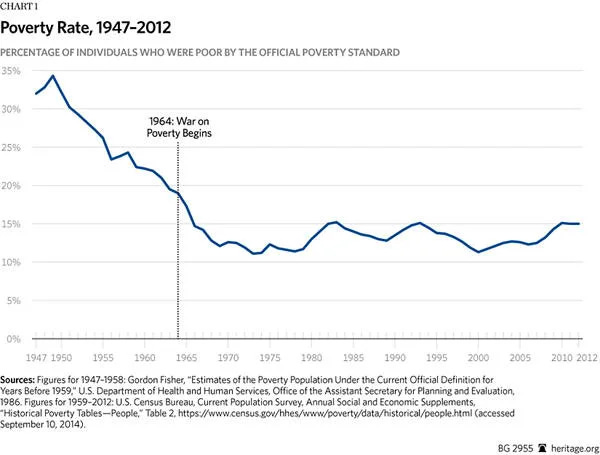Constructing a new Pathway to Success
that enables youths from low-income families to experience Upward Mobility
This article is part of my ongoing series of excerpts from my forth-coming book entitled “Upward Mobility: A Radical New Agenda to Uplift the Poor and Working Class.” This book is the third book in my From Poverty to Progress book series, where I argue in favor of a Progress-based reform agenda focused on the following principles:
Promote long-term economic growth (this is what I call “Promoting Progress”, the topic of my second book)
Create a prosperous working class.
Promote a clear pathway that enables youths from low-income families to enter the prosperous working class.
In this post, I will focus on the third principle: Promote a clear pathway that enables youths from low-income families to enter the prosperous working class. In particular, I will focus on how we can modernize The Traditional Pathway to Success that did so much to help previous generations of Americans make wise Life Choices to promote their own Upward Mobility.
See more articles on Upward Mobility:
Why Progress and Upward Mobility should be the goal, not Equality
Constructing a modernized Pathway to Success (this article)
I also will be writing a significant number of excerpts from my forthcoming book: Upward Mobility: A Radical New Agenda to Uplift the Poor and Working Class. Most of these excerpts will only be available to paid subscribers.
Other books in my “From Poverty to Progress” book series:
To promote Upward Mobility, I believe that you need two things. First, the society has to experience long-term economic growth. Without long-term economic growth, Upward Mobility is a zero-sum struggle where only a few can win. And throughout history, political and economic institutions have ensured that only children born into elite families can win at that game. With long-term economic growth, however, the vast majority of citizens can experience an increasing material standard of living over the course of their lifetime. This then builds a foundation for their children to continue increasing their material standard of living.
Second, the individual has to make critical Life Choices that enable them to join in on the material progress that surrounds them. This maximizes their chances of experiencing an increasing material standard of living. Notice that it does not guarantee success, and it certainly does not guarantee being rich and famous. Nor does it lead to Equality of Outcome (which cannot be achieved).
Good Life Choices come from:
Economic incentives from material reality.
Economic incentives from our institutions.
Cultural values, in particular, what society teaches youths on how they can achieve a successful life.
The economic incentives from material reality are simple. Humans are biological organisms that require energy to survive and reproduce. We need to perform some type of activity to acquire the necessary energy in the form of food. In the past, we did so directly by gathering wild food, hunting, fishing, herding animals, or farming. Now we do so by working for an organization that sells a product or service in the marketplace. This work:
Provides for our own material needs
Forces us to learn to work with others and grow as a person
Contributes to material progress for society
Creates a role model for the next generation on how to do the above.
With the modern invention of the welfare state, we have added economic incentives from our institutions. In particular, means-tested social programs give away many of the benefits of employed labor without the need for labor. In addition, the government taxes employed labor via income taxes and payroll taxes. This fundamentally changes the incentives of material reality. Material reality forces labor, but the welfare state creates additional options. Sometimes those options align with long-term benefits, but far too often they conflict with them.
Values also matter. Different individuals and different cultures value status, work, education, saving, staying close to family, conforming with the group, leisure time, entertainment, and other goals differently. This leads to children being taught to prioritize certain values over others. Those values then lead to important life choices, which play an important role in their material standard of living.
Ideally, all three factors align so that youths can make the correct Life Choices during the critical years between the ages of 14 and 30. Unfortunately, this is often not the case.
I have argued that Americans believed until the mid-1960s believed in a Traditional Pathway to Success and the economic incentives of social programs did not create economic disincentives that undermined wise Life Choices. This when combined with the strong economic growth promoted Upward Mobility for working-class and poor Americans. This Upward Mobility was only broken by recessions, depressions, and wars for almost 200 years.
In the 1960s two fundamental developments undermine this Upward Mobility. In the mid-1960s LBJ and the Democratic party implemented a very large number of means-tested social programs that fundamentally changed economic incentives from our institutions. A few years later, college-educated Baby Boomers revolted against the Traditional Pathway to Success. The combination of the two seriously undermined Upward Mobility for the American working class and poor.
Modernizing the Pathway to Success
To assist youths in making the right life choices, we need to construct a modernized Pathway to Success to take the place of the Traditional Pathway to Success. This new pathway must have a strong foundation. It cannot be purely based upon a conviction or traditional beliefs, as the traditional version was.
Many conservatives support the traditional way of doing things just because it is a tradition. Conservatives tend to value Tradition. Many on the Left oppose the traditional way of doing for the opposite reason. Those on the Left tend to be suspicious of Tradition and want to create a better world. Both cannot be right. We need some means of assessing whether a tradition leads to positive results for the individual and society. And if not, then we need to substitute it with something that leads to positive results for the individual and society.
The modernized Pathway to Success must be based on solid real-world data on what works in promoting Upward Mobility. And most importantly, our social programs must create an incentive structure that reinforces the pathway instead of undermining it as they do today.
Metric for success
Obviously, the term “success” can mean different things to different people. I have no intention of getting into a philosophical argument evaluating each perspective.
For this book, I will use two metrics:
Earned income from employment by household members between the ages of 30 and 55. Wherever possible, I will exclude income in the twenties as those youths are just starting out, and many people over age 55 are retired. For most data, this is not possible, so I will use income from employment.
Self-reported happiness
Unfortunately, there is far more data on earned income than there is for self-reported happiness, so I focus primarily on income. Fortunately, there is a substantial amount of evidence that income and happiness are closely associated with each other. In addition, virtually every metric of material progress is closely associated with per capita GDP and income.
Criteria for inclusion
The inclusion of individual steps in this modernized Pathway to Success should be based on the following criteria:
At least 90% of youths can realistically take the step.
The step must have a great deal of social science data documenting that it is associated with higher incomes in the long term.
There is an intuitive and plausible link that most people can immediately grasp that links the step to long-term success and happiness.
The Pathway must be achievable
As for the first condition, I believe that it would be unfair to include a step in the Pathway to Success that cannot be achieved by the vast majority of youths. For example, we could include “go to college” or “get a four-year college degree”, or worse “get a four-year degree from Harvard.”
While achievable for some, these steps are likely beyond the reach of most youths even under the best conditions. Particularly for youths raised in lower-income families, this would be setting most up for failure. While preaching almost unattainable goals might inspire a few youths to channel that inspiration into real action that achieves results, it will likely convince most youths that success is beyond their capabilities. The vast majority of youths will give up and resign themselves to their fate. Over time, youths will just tune out the message.
The Pathway must be based on results
As for the second condition, we should ideally expect large numbers of Randomized Controlled Trials (RCTs) to prove the long-term effectiveness of the step. Given the depressingly small number of RCTs that have been completed so far, this level of proof is typically not possible.
In most cases, all that can be done is compare the incomes of those who have completed the step with those who have not. In some cases, detailed studies of the policies provide additional evidence of the efficacy for youths taking the step.
The Pathway must be based on intuitive
As for the third condition, I believe that it is important that the American public as well as low-income youths can easily grasp the benefits of taking a step. While we need sophisticated policy experiments to back up our intuition, a sophisticated analysis should not be required to convince the typical person.
To succeed both the American public and low-income youths must buy into the concept of the Pathway to Success. The American public is critical because they must ultimately pay for the programs. Strong public support will lead to strong support from elected officials which will lead to funding large enough and for a duration long enough to show actual results. More importantly, the Pathway will be far more successful if all American adults openly advocate for it to their children and neighbors.
Low-income youths must buy into the message because it is their lives that are at stake. If they do not truly believe that each step of the Pathway to Success is worth sacrificing for in the short term, they will simply ignore it and make other choices. Each step must make sense to them, align with their values, and seem achievable with a reasonable amount of effort.
In the following articles, I will sketch out a modernized version of the Pathway to Success.
See more articles on Upward Mobility:
Why Progress and Upward Mobility should be the goal, not Equality
Constructing a modernized Pathway to Success (this article)
I also will be writing a significant number of excerpts from my forthcoming book: Upward Mobility: A Radical New Agenda to Uplift the Poor and Working Class. Most of these excerpts will only be available to paid subscribers.
Other books in my “From Poverty to Progress” book series:









I am no fan of “tradition,” but I am a fan of logic and common sense. You are correct to talk about incentives:
As a general rule, when we tax something, we get less of it. So when we tax work, we get less work.
On the flip side, when means tested welfare programs have benefits cliffs that cut off when someone gets a job, there is no incentive to do so.
Nothing about this makes any sense.
To the extent possible, we must lower taxes on incomes (and production) and remove “benefits cliffs” that trap people on welfare.
Very promising discussion. Probably means we need to take a rhetorical meat ax to the Great Society, or selected elements of it -- based on a serious comparison of applicable metrics before and after.
Some of Thomas Sowell's work seems to address this.
We need to re-emphasize TANSTAAFL as a core adage and belief.
Your upward mobility endeavor is why I have been following your posts.
When is your 3rd book due to be published?